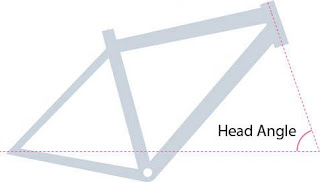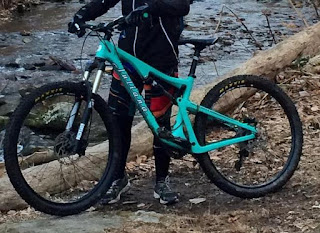One of my best friends from home, Mia, is a huge mountain biker, and every time we come home (Thanksgiving and winter break being no exceptions), the two of us always talk about the possibilities of going out for a ride together. Mia and I are both huge fans of trail riding, which can involve both climbing hills, and riding down steep, uneven trails with often rocky or root-ridden terrain. However, in the past several years, my family has cleaned out our garage and gotten rid of many of our old bikes, leaving me bike-less.
This past summer, Mia had to warranty a bike frame that she had been using since high school (shown above; truly a loss), and she chose to invest in a new bike. However, from the warranty, she also received a brand new version of her old Juliana Furtado frame. She had been considering what to do with the new frame, but given my predicament, she offered to sell it to me and help me build a bike! Sounds perfect, right? Sadly, no...
One intuitively knows that bikes are not one-size-fits-all, otherwise children and adults would be riding around on the same sets of wheels. However, when it comes to more specialized bikes, these frame sizes and shapes become more important, especially when it comes to one's center of mass on the bike and the effect this has on the ride itself.
When buying mountain bikes, they often come in XS-XXL sizes from the manufacturers, with each size approximated to fit riders of certain height and/or weight ranges. For the size-small Juliana Furtado frame that Mia received, this range is between 5'2" and 5'6", with Mia standing at about 5'2" fitting perfectly in the range. I am roughly 5'6", which is theoretically the upper limit of the size-small range, but this is where weight also comes into play. In general, humans have a center of mass located at their lower stomach/hip area. While the difference in height between Mia and my centers of mass is relatively small, the size of our centers of mass differ depending on how much we weigh. When riding a bike, balance is extremely important for staying on two wheels, but it becomes significantly more important when going at reasonable speeds on uneven terrain. As a result, having a center of mass that is higher off the ground on the bike can lead to greater imbalance during the ride, and a higher risk of wiping out... This I know from experience... Given that I weigh approximately 20-30 lbs more than Mia, our centers of mass are likely different enough that if I were to ride the same bike frame, I would likely have to compensate in other ways for my larger center of mass, even though we are only four inches different in height. In some ways, this could be accomplished through changing my positioning on the bike.
Relaxed Road-Biking Posture
Downhill Posture
Uphill Posture

For road biking, it is common for riders to sit with a bit of a relaxed, slightly inclined posture (shown above). In physics terms, this positioning causes the rider's center of mass to be roughly where the rider's hips are on the seat, in the approximate center of the bike. However, this posture is largely only favorable in flatter conditions. When riding down steep terrain, having a centralized center of mass not only leads to imbalance on the bike, but also can result in unintentional increase in speed while riding. This I also know from personal experience... Instead, for mountain-biking downhill, it is much more favorable for riders to stand with their pedals level, and lean their hips back over the back wheel (shown above). This position shifts the center of mass of the rider + bike toward the back wheel of the bike, and lowers the center of mass to the ground in comparison to if the rider were seated. However, when climbing, it is far more favorable to stand and lean forward (shown above), shifting one's center of gravity over the pedals and toward the front wheel to increase traction and pedaling power. Unfortunately, this also results in a higher center of mass on the bike but is unavoidable when riding trails.

Riding a bike takes much more than just balancing on two wheels, especially in trail riding. Almost all bike frames have the same basic structure of a top tube and a down tube that connect to the head tube, seat stays and chain stays that hold the back wheel, and a seat tube. However, different types of bikes have differences in their structure and the geometry.


On the left is a generic road bike. Here, there is no suspension built into the frame, and both the top tube and down tube are relatively equal in thickness. Also, the seat stays are directly connected to the seat tube where the head tube reaches the seat tube. Similarly, the fork (part that holds the front wheel) has no suspension, and comes with the frame. On the right is Mia's beloved Juliana. Here, the bike is full suspension. The fork is separate from the frame, allowing one to choose how much cushion they want in the front of the bike, and the seat stays and chain stays (now also much studier) are no longer connected directly to the seat tube. Instead, they are connected via a shock absorber to the top tube. These differences in construction are designed to help each bike deal with the stresses of their aspects of the sport appropriately (physics currently beyond our understanding in this class). There is a noticeable difference in the geometry of the bikes as well. For the road bike, the construction of the frame appears to be much more level, with the top tube parallel to the ground. However, for the trail bike, there is a more of an angle to the frame overall. This is especially noticeable for the angle of the head tubes, or the head angles of these bikes.

The head (tube) angle dictates the ability of the suspension (especially the front suspension that fits through the head tube) to absorb impacts while riding, and can affect how easy it is for the rider to control the bike. Having a slacker (smaller) head angle can make the bike less responsive to steering in tight corners, but can allow the bike's suspension to better absorb impacts while riding downhill and increase stability since the wheels are further apart. Having a steeper (larger) head angle can make the bike easier to ride uphill and easier to handle on winding tracks, but can also feel less stable at high speeds and more like you might be flung over the handlebars. For most trail bikes with 27.5" wheels, this head angle generally ranges from about 66.5 to 68 degrees, with mountain bikes generally ranging from 62 to 73 degrees.
According to the specifications for the Juliana, the head tube angle is a fairly slack at ~66.5 degrees, making it more well balanced for downhills but still good for climbing. Given the position of the the rider's center of gravity over the bottom bracket (where the pedals attach), this geometry makes for more efficient transfer of force from the rider's pedaling to the rotation of the wheels as well, since the rider's weight can be leveraged when pedaling. However, the slack of the head angle does not help my situation much. Since the bike would be fairly slack, my center of mass would be slightly lower than if I used a different bike with a steeper head angle, but this geometry would not help my case much, given the difference between a 66.5 and a 68 degree head angle would only translate to mild differences in the wheelbase (distance between the tires). In this way, the Juliana Furtado could be a slightly more forgiving frame as far as trail bikes go, but only by a small margin.
There are other aspects to consider when buying a bike, including comfort, reach, etc., but in the end, I sadly had to turn Mia down because of my worries about the fit of the bike frame impairing our trail adventures, among other reasons. However, hopefully, with this knowledge of the physics of bike frames, I'll be able to find one that will get me back on the trails on a bike, and not on my face.






















